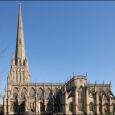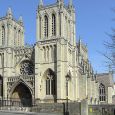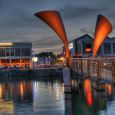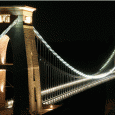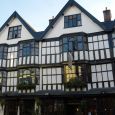Bristol
Advertisement
By Air
Bristol International Airport receives flights from many domestic and European destinations and is located to the southwest of the city centre. Although situated a distance from Bristol, getting to the city from the airport is straightforward, with the popular and frequent Bristol International Flyer shuttle providing fast access. Taxis also serve the city from the airport.
By Rail
Bristol is well served by rail, with fast transfer times from London's Paddington Station to Temple Meads Station, situated to the east of Bristol city centre. Services also come in from other major UK centres including Birmingham and Cardiff. The journey time from London is only 1 hour 30 minutes and first-class seats are available; travel time to and from Bath is only 25 minutes.
By Bus
With the excellent rail services into Bristol, travelling by bus is not really necessary. However, if you are on a tight budget, National Express run coaches to Bristol on a regular basis from towns and cities all over the UK, either directly or with a change. Bristol Bus Station is located on Marlborough Street, close to the city centre. Local buses serve important tourist destinations in the city and are run by First.
By Car
Bristol is easy to get to by car from any direction, with the M4 motorway linking the city with London and the M5 approaching from the north and south. If you are driving from London, take the M4 west and exit at Junction 19 onto the M32 spur for Bristol; the A4032 continues into Bristol from the M32. The M5, M4 and the M32 come in from a northerly direction; the A4 and the A369 come in from the west, either side of the River Avon; and the M5 and the A38 provide access from the south, along with the A4 from Bath. Driving through Bristol city centre during morning and afternoon rush hours can be tough, owing to heavy traffic, the bus and taxi lanes and the many one-way systems.
Advertisement
St Mary Redcliffe
When Queen Elizabeth I visited Bristol in 1574 she described St Mary Redcliffe as "the fairest parish church in England". Begun in the 13th century and paid for by wealthy merchants, the church is situated on the south side of the Floating Harbor. It takes its name from the red cliffs on which it stands. The spire, 290ft/88m high, is a 19th century addition. The interior is of enchanting elegance with its tall arches, slender clustered pillars and reticulated vaulting. Particularly fine is the hexagonal north porch, with its richly decorated doorway. The wealth and splendor of the church is due to one of the richest merchants of the day, William Canynge, whose tomb can be seen in the south transept. He is commemorated at a special service on Whit Sunday. Also to be found in the church are the memorial tablet and tomb of Admiral Sir William Penn, father of the William Penn who founded Pennsylvania in the USA.
Trinity Cathedral
One of Bristol's two famous churches is Trinity Cathedral, originally the church of an Augustinian house but raised to cathedral status in 1542 when Henry VIII created a new diocese. Apart from the chapter house nothing remains of the Norman abbey, consecrated in 1165. Construction of the present church spans almost six hundred years. The east end, superbly rebuilt in the Decorated style by Abbot Knowle, dates from between 1298 and 1330. The central tower and transepts were the next to be completed (by 1500), after which building stopped. The nave and towered west facade are 19th century. The cathedral is a hall church, a type unusual in England but quite common, for example, in southern Germany. It is built without triforium or clerestory the aisles and nave being of the same height. The Decorated style is seen most clearly in the clusters of pillars and the ribbed vaulting.
Floating Harbor
Nowadays the bigger freighters and passenger vessels are built further downstream, at large modern yards in Avonmouth and Portbury on the Severn Estuary. The old Port of Bristol on the Avon has been given a new and imaginative lease of life, with many wharves and warehouses converted or restored. Traditionally known as the Floating Harbor it is now an area full of delightful surprises.
Clifton Suspension Bridge
No visitor should leave Bristol without seeing the famous Clifton Suspension Bridge. It spans the 260ft/80m deep Avon Gorge on the west side of the limestone plateau known as Clifton Down and Durdham Down. Measuring 702ft/214m between the piers the bridge was completed in 1864, 33 years after Brunel (died 1859) had first submitted his prize winning plans.
Llandoger Trow
The most famous of Bristol harbor area's many bars and taverns is the triple gabled, half timbered Llandoger Trow in King Street, built in 1669. Here Alexander Selkirk is said to have told the story of his shipwreck to Daniel Defoe (1660-1731), who immortalized it in "Robinson Crusoe". The Llandoger Trow was also the model for the "Admirable Benbow", the inn frequented by Long John Silver in "Treasure Island" by Robert Louis Stevenson (1850-94). Carefully restored in 1991 the tavern is linked by an underpass to the Theatre Royal on the opposite side of the street.
Information not available
January - February -> 2(°C) - Winter
July - August -> 26(°C) - Summer
Advertisement

